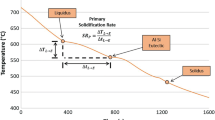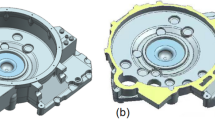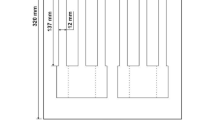Abstract
The combined effects of heat treatment and strontium (Sr) additions on the microstructure and mechanical properties of high pressure die cast A383 alloy components were investigated. A series of high pressure die cast engine components were produced using combined Sr additions and heat treatments. The resulting micro- and nanostructures were characterized using optical and electron microscopies. The tensile behavior was measured for material taken from the bulkhead sections of the engine bock. The results showed that Sr additions increased the elongation, but not the strength, of as-cast A383 alloys due to the refinement of the Al–Si eutectic. Heat treatment combined with Sr addition improved the strength because of the formation of fine nano-precipitates with a high number density. The results suggest that the formation of these precipitates may be affected by the Sr additions. This same combination also improved the ductility by maintaining the small size and roundness of the Al–Si eutectic particles.
Access provided by CONRICYT-eBooks. Download conference paper PDF
Similar content being viewed by others
Keywords
Introduction
Light aluminum alloys have been commercially used to manufacture automotive engine blocks due to their good castability, high strength-to-weight ratio and satisfactory ductility [1]. High pressure die casting has very high solidification rates (even up to 1000 K/s) and a low cycle time. As such, it has been widely applied in the automotive industry [2]. Moreover, the high pressure die casting process generates a fine, cast microstructure and therefore increases the mechanical properties of components [3].
Generally, heat treatment and modification of the Al–Si eutectic are the most commonly used approaches to improve the mechanical properties of Al–Si casting alloys. Sr and other alkali and rare earth elements, such as Na and Eu [4, 5], are effective modifiers that change the morphology of Al–Si eutectic particles from long-needle like particles to smaller and more rounded ones. It is now widely accepted that Sr atoms can accumulate at the interface between Si particles and the Al matrix and change the growth behavior of Si from anisotropic to isotropic [6, 7]. This change in Al–Si eutectic morphology enhances the ductility of the cast material. In addition, the formation of fine nano-precipitates (Al2Cu) due to heat treatment after casting enhances the strength of Al–Si–Cu alloys such as A380 and A383 [8]. However, there is limited reporting concerning the combined effects of Sr modification and heat treatment on the mechanical properties, microstructures, and nanostructures of high pressure die cast (HPDC) Al–Si–Cu alloys. In the present work, microstructural evolution and mechanical performance of HPDC modified-A383 aluminum alloy with Sr additions and post-casting heat treatment were investigated.
Experimental Procedures
Specimens for microstructural observations and crystallographic analyses were taken from the bulk heads of several HPDC A383 (the composition is shown in Table 1) engine blocks provided by Nemak Inc. in Alabama, USA. Four groups of HPDC alloys were selected as: (1) Sr modification with heat treatment (HT), (2) no Sr modification with HT, (3) no Sr modification as-cast (without HT) and (4) Sr modification as-cast (without HT). Sr additions of less than 200 ppm were added into the molten metal for modification. Heat treatment was conducted after the casting process at 170 °C for 12 h without a solution treatment. Optical microscope (Nikon Model Epiphot 200), SEM (JEOL 7000) and FEI Tecnai F-20 Scanning/Transmission Electron Microscope [(S)TEM] were used to characterized the microstructures of HPDC A383 Al alloys. The measurement of Si particles, including area fraction, size, was conducted using the Adobe Photoshop software. At least 10 areas (under 500× magnification) were selected randomly on each polished section for these measurements.
Experimental Results
Influences of Sr Additions and Heat Treatment on the Mechanical Properties of HPDC A383 Alloys
Post-casting heat treatment increased the yield strength but decreased the elongation of HPDC A383 alloys , as shown in Fig. 1. The yield strength clearly increased by nearly 50 MPa for the heat-treated materials with or without Sr additions. However, the elongation decreased more for the Sr-modified (red and blue points) materials than for those without Sr addition (green and orange points). When comparing the two heat-treated materials, the addition of Sr enhanced both the elongation and the yield strength (green and red points). The increase in ductility with Sr addition is a well-known effect, but the increase in yield strength is a new observation. Here we present results for 30 samples taken from multiple castings for each of the four conditions. Based upon these results, Sr addition does appear to increase the yield strength after heat treatment under the particular conditions used for these castings. Future work will examine how prevalent this effect is over a range of casting conditions.
Tensile properties of HPDC A383 alloys under four different conditions: a Sr modification with heat treatment (HT) (red squares), b no Sr modification with HT (green circles), c no Sr modification as-cast (without HT) (orange upward triangles) and d Sr modification as-cast (without HT) (blue downward triangles). Each symbol on the plot represents one tensile test result
Effects of Sr Additions and Heat Treatment on the Microstructures of HPDC A383 Alloys
The addition of Sr modified the Al–Si eutectic from a long, needle-like morphology to a fine-fibrous structure regardless of heat treatment (Fig. 2). However, heat treatment alone had no effect on the morphology of the Al–Si eutectic. These results are to be expected and are in keeping with previous literature [9, 10].
The α-Al phase had equiaxed grains instead of columnar dendrites due to a high cooling rate during the HPDC process, as shown in Fig. 2. Electron backscatter diffraction (EBSD) results showed that the grain size in the primary α-Al was in the range of 11.1–14.5 μm. The grain size of α-Al was not meaningfully changed by either the Sr additions or the post-casting heat treatment. A limited number of Fe-rich intermetallics were also observed in the microstructures of the high pressure die cast alloys. The “sludge” phase with nominal composition of Al13.26(Fe, Mn, Cr)3.24Si2 was observed in each sample, as indicated by arrows in Fig. 2. No β-phase Fe-rich intermetallics were observed in these materials, most likely because the cooling rate was too high to allow for their nucleation and growth.
Effect of Sr Additions on the Aging Precipitates in HPDC A383 Alloys
The addition of Sr facilitated the formation of finer Al2Cu aging precipitates with a higher distribution density within the Al matrix, as shown in Fig. 3. The bright, thin needle-like phases were Al2Cu aging precipitates which contained Cu with a higher average atomic number than the Al matrix as shown in the high angle annular dark field (HAADF) images in Fig. 3a, b. Al2Cu precipitates in the sample with Sr addition (Fig. 3b) were shorter in length compared with the sample without Sr (Fig. 3a). Moreover the number density of Al2Cu precipitates was higher in the sample with Sr addition (71/μm2 shown in Fig. 3b) than in the sample without Sr addition (48/μm2 as shown in Fig. 3a).
Discussion
Relationship Between Microstructures and Mechanical Properties of HPDC A383 Alloys
The change in the elongation of the HPDC alloys tested was controlled by the morphology of Al–Si eutectic. There was an inverse relationship between the size of the Si eutectic particles and the elongation of HPDC alloys (Fig. 4). The smaller the eutectic Si particles were, the higher the elongation of the sample was. The addition of Sr modifies the eutectic Si particles from a long, needle-like morphology to a fine, rounded morphology and thus effectively reduces the stress concentration effect at the sharp corners of the Si needles. The degree of interconnectivity between Al matrix and Si particles, particularly in the eutectic regions, also increases with Sr modification. The greater connectivity between Al and Si in eutectic region will enhance the overall ductility of the component material.
The change in the yield strength of HPDC alloys was caused primarily by the formation of Al2Cu aging precipitates after heat treatment, as shown in Figs. 1 and 3. It is expected that the formation of these precipitates will increase yield strength. The suggestion from this data that the addition of Sr could affect the aging process (generate finer aging precipitates with higher number density) is a new observation. It has been widely accepted that Sr will segregate to the Al/Si interface and thus affect the growth direction of Si [11,12,13]. In the present work, somewhat finer Al2Cu precipitates were observed in the heat-treated samples when Sr was added compared with samples without the addition of Sr, as shown in Fig. 3. One possibility is that Sr could segregate to the interfaces between Al2Cu precipitates and the Al matrix, thus hindering the diffusion of Cu atoms from the Al matrix to the interface thereby limiting the growth of Al2Cu in the long direction. Future work will make a detailed examination of the presence of Sr at the Al–Al2Cu interfaces.
Conclusions
The individual and combined effects of Sr addition and post-casting heat treatment on the microstructures, nanostructures, and mechanical properties of HPDC A383 alloys were investigated. The main conclusions are:
-
(1)
The addition of Sr increases the elongation of HPDC A383 alloys due to the refinement effect of Sr on the eutectic Si particle morphology, from a long-needle like morphology to a fine-fibrous like morphology.
-
(2)
Post-casting heat treatment significantly increases the strength of HPDC A383 alloys, but it decreases the elongation.
-
(3)
The addition of Sr seems to reduce the size and increase the density of the Al2Cu aging precipitates after heat treatment.
References
Ye H. (2003). An overview of the development of Al-Si-alloy based material for engine applications. Journal of Materials Engineering and Performance, 12(3), 288–297
Timelli G, Fabrizi A (2014) The effects of microstructure heterogeneities and casting defects on the mechanical properties of high-pressure die-cast AlSi9Cu3 (Fe) alloys. Metallurgical and Materials Transactions A 45(12): 5486–5498
Bonollo F, Gramegna N, Timelli G (2015) High-Pressure Die-Casting: Contradictions and Challenges. JOM 67(5): 901–908
Zarif M, Mckay B, Schumacher P (2011) Study of heterogeneous nucleation of eutectic Si in high-purity Al-Si alloys with Sr addition. Metallurgical and Materials Transactions A 42(6): 1684–1691
Timpel M, Wanderka N, Schlesiger R, Yamamoto T, Lazarev N, Isheim D, Schmitz G, Matsumura S, Banhart J (2012) The role of strontium in modifying aluminum–silicon alloys. Acta Materialia 60(9): 3920–3928
Hogan LM, Kobayashi KF, Shamsuzzoha M (1989) Discussion of “the mechanism of silicon modification in aluminum-silicon alloys: Impurity-induced twinning”. Metallurgical & Materials Transactions A 20(7):1286–1288
Li JH, Zarif MZ, Dehm G, Schumacher P (2012) Influence of impurity elements on the nucleation and growth of Si in high purity melt-spun Al–Si-based alloys. Philosophical Magazine 92(31): 3789–3805
Roy S, Allard LF, Rodriguez A, Watkins TR, Shyam A (2017) Comparative Evaluation of Cast Aluminum Alloys for Automotive Cylinder Heads: Part I—Microstructure Evolution. Metallurgical and Materials Transactions A 48(5): 2529–2542
Farahany S, Dahle AK, Ourdjini A, Hekmat-Ardakan A (2016) Flake-fibrous transition of silicon in near-eutectic Al-11.7 Si-1.8 Cu-0.8 Zn-0.6 Fe-0.3 Mg alloy treated with combined effect of bismuth and strontium. Journal of Alloys and Compounds 656: 944–956
Kruglova A, Engstler M, Gaiselmann G, Stenzel O, Schmidt V, Roland M, Diebels S, Mücklich F (2016) 3D connectivity of eutectic Si as a key property defining strength of Al–Si alloys. Computational Materials Science 120: 99–107
Li JH, Albu M, Hofer F, Schumacher P (2015) Solute adsorption and entrapment during eutectic Si growth in A–Si-based alloys. Acta Materialia, 2015, 83:187–202
Timpel M, Wanderka N, Kumar GV, Banhart J (2011) Microstructural investigation of Sr-modified Al–15wt% Si alloys in the range from micrometer to atomic scale. Ultramicroscopy 111(6): 695–700
Srirangam P, Chattopadhyay S, Bhattacharya A, Nag S, Kaduk J, Shankar S, Banerjee R, Shibata T (2014) Probing the local atomic structure of Sr-modified Al–Si alloys. Acta Materialia 65: 185–193
Acknowledgements
The authors are very grateful to the Alabama State Department of Commerce (Alabama Innovation Fund) and Nemak Inc. for financial support of this research.
Author information
Authors and Affiliations
Corresponding author
Editor information
Editors and Affiliations
Rights and permissions
Copyright information
© 2018 The Minerals, Metals & Materials Society
About this paper
Cite this paper
Liu, T. et al. (2018). The Combined Effects of Sr Additions and Heat Treatment on the Microstructure and Mechanical Properties of High Pressure Die Cast A383 Alloy. In: Martin, O. (eds) Light Metals 2018. TMS 2018. The Minerals, Metals & Materials Series. Springer, Cham. https://doi.org/10.1007/978-3-319-72284-9_35
Download citation
DOI: https://doi.org/10.1007/978-3-319-72284-9_35
Published:
Publisher Name: Springer, Cham
Print ISBN: 978-3-319-72283-2
Online ISBN: 978-3-319-72284-9
eBook Packages: Chemistry and Materials ScienceChemistry and Material Science (R0)








